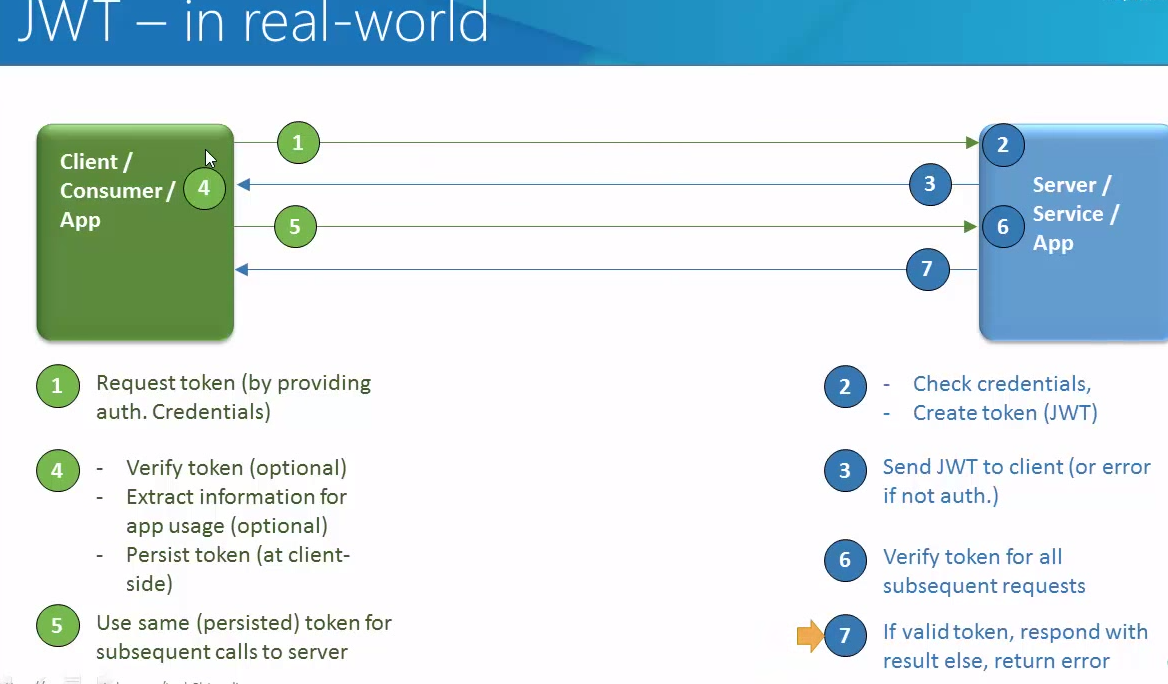In my previous article , I talked about JWT introduction and how it works. There are multiple libraries by which you can implement JWT in Java.
1. Java JWT: JSON Web Token for Java and Android
Installation
Use your favorite Maven-compatible build tool to pull the dependency (and its transitive dependencies) from Maven Central:
Maven:
<dependency>
<groupId>io.jsonwebtoken</groupId>
<artifactId>jjwt</artifactId>
<version>0.6.0</version>
</dependency>
Gradle:
dependencies {
compile 'io.jsonwebtoken:jjwt:0.6.0'
}
Note: JJWT depends on Jackson 2.x. If you’re already using an older version of Jackson in your app, read this
Usage
Most complexity is hidden behind a convenient and readable builder-based fluent interface, great for relying on IDE auto-completion to write code quickly. Here’s an example:
import io.jsonwebtoken.Jwts;
import io.jsonwebtoken.SignatureAlgorithm;
import io.jsonwebtoken.impl.crypto.MacProvider;
import java.security.Key;
// We need a signing key, so we'll create one just for this example. Usually
// the key would be read from your application configuration instead.
Key key = MacProvider.generateKey();
String s = Jwts.builder().setSubject("Joe").signWith(SignatureAlgorithm.HS512, key).compact();
How easy was that!?
Now let's verify the JWT (you should always discard JWTs that don't match an expected signature):
assert Jwts.parser().setSigningKey(key).parseClaimsJws(s).getBody().getSubject().equals("Joe");
You have to love one-line code snippets!
But what if signature validation failed? You can catch SignatureException and react accordingly:
try {
Jwts.parser().setSigningKey(key).parseClaimsJws(compactJwt);
//OK, we can trust this JWT
} catch (SignatureException e) {
//don't trust the JWT!
}
2. Using Nimbus Jose + JWT
The most popular and robust Java library for JSON Web Tokens (JWT)
Supports all standard signature (JWS) and encryption (JWE) algorithms
Open source Apache 2.0 licence
Features –
– Signed / encrypted tokens, such as bearer access tokens in OAuth 2.0 or OpenID Connect identity tokens;
– Self-contained API keys, with optional revocation;
– Protecting content and messages;
– Authenticating clients and web API requests.
Use in Java
// Create an HMAC-protected JWS object with some payload
JWSObject jwsObject = new JWSObject(new JWSHeader(JWSAlgorithm.HS256),
new Payload("Hello world!"));
// We need a 256-bit key for HS256 which must be pre-shared
byte[] sharedKey = new byte[32];
new SecureRandom().nextBytes(sharedKey);
// Apply the HMAC to the JWS object
jwsObject.sign(new MACSigner(sharedKey));
// Output to URL-safe format
jwsObject.serialize();
Maven configuration
Maven
For Java 7+ :
<dependency>
<groupId>com.nimbusds</groupId>
<artifactId>nimbus-jose-jwt</artifactId>
<version>4.11.2</version>
</dependency>
3. JSON token library – It depend on Google Guava.The library is in fact used by Google Wallet.
Here is how to create a jwt, and to verify it and deserialize it:
Maven –
<dependency>
<groupId>com.googlecode.jsontoken</groupId>
<artifactId>jsontoken</artifactId>
<version>1.0</version>
</dependency>
<dependency>
<groupId>com.google.guava</groupId>
<artifactId>guava</artifactId>
<version>18.0</version>
</dependency>
and Java implementation –
import java.security.InvalidKeyException;
import java.security.SignatureException;
import java.util.Calendar;
import java.util.List;
import net.oauth.jsontoken.JsonToken;
import net.oauth.jsontoken.JsonTokenParser;
import net.oauth.jsontoken.crypto.HmacSHA256Signer;
import net.oauth.jsontoken.crypto.HmacSHA256Verifier;
import net.oauth.jsontoken.crypto.SignatureAlgorithm;
import net.oauth.jsontoken.crypto.Verifier;
import net.oauth.jsontoken.discovery.VerifierProvider;
import net.oauth.jsontoken.discovery.VerifierProviders;
import org.apache.commons.lang3.StringUtils;
import org.bson.types.ObjectId;
import org.joda.time.DateTime;
import com.google.common.collect.Lists;
import com.google.gson.JsonObject;
/**
* Provides static methods for creating and verifying access tokens and such.
* @author davidm
*
*/
public class AuthHelper {
private static final String AUDIENCE = "NotReallyImportant";
private static final String ISSUER = "YourCompanyOrAppNameHere";
private static final String SIGNING_KEY = "[email protected]^($%*$%";
/**
* Creates a json web token which is a digitally signed token that contains a payload (e.g. userId to identify
* the user). The signing key is secret. That ensures that the token is authentic and has not been modified.
* Using a jwt eliminates the need to store authentication session information in a database.
* @param userId
* @param durationDays
* @return
*/
public static String createJsonWebToken(String userId, Long durationDays) {
//Current time and signing algorithm
Calendar cal = Calendar.getInstance();
HmacSHA256Signer signer;
try {
signer = new HmacSHA256Signer(ISSUER, null, SIGNING_KEY.getBytes());
} catch (InvalidKeyException e) {
throw new RuntimeException(e);
}
//Configure JSON token
JsonToken token = new net.oauth.jsontoken.JsonToken(signer);
token.setAudience(AUDIENCE);
token.setIssuedAt(new org.joda.time.Instant(cal.getTimeInMillis()));
token.setExpiration(new org.joda.time.Instant(cal.getTimeInMillis() + 1000L * 60L * 60L * 24L * durationDays));
//Configure request object, which provides information of the item
JsonObject request = new JsonObject();
request.addProperty("userId", userId);
JsonObject payload = token.getPayloadAsJsonObject();
payload.add("info", request);
try {
return token.serializeAndSign();
} catch (SignatureException e) {
throw new RuntimeException(e);
}
}
/**
* Verifies a json web token's validity and extracts the user id and other information from it.
* @param token
* @return
* @throws SignatureException
* @throws InvalidKeyException
*/
public static TokenInfo verifyToken(String token)
{
try {
final Verifier hmacVerifier = new HmacSHA256Verifier(SIGNING_KEY.getBytes());
VerifierProvider hmacLocator = new VerifierProvider() {
@Override
public List<Verifier> findVerifier(String id, String key){
return Lists.newArrayList(hmacVerifier);
}
};
VerifierProviders locators = new VerifierProviders();
locators.setVerifierProvider(SignatureAlgorithm.HS256, hmacLocator);
net.oauth.jsontoken.Checker checker = new net.oauth.jsontoken.Checker(){
@Override
public void check(JsonObject payload) throws SignatureException {
// don't throw - allow anything
}
};
//Ignore Audience does not mean that the Signature is ignored
JsonTokenParser parser = new JsonTokenParser(locators,
checker);
JsonToken jt;
try {
jt = parser.verifyAndDeserialize(token);
} catch (SignatureException e) {
throw new RuntimeException(e);
}
JsonObject payload = jt.getPayloadAsJsonObject();
TokenInfo t = new TokenInfo();
String issuer = payload.getAsJsonPrimitive("iss").getAsString();
String userIdString = payload.getAsJsonObject("info").getAsJsonPrimitive("userId").getAsString();
if (issuer.equals(ISSUER) && !StringUtils.isBlank(userIdString))
{
t.setUserId(new ObjectId(userIdString));
t.setIssued(new DateTime(payload.getAsJsonPrimitive("iat").getAsLong()));
t.setExpires(new DateTime(payload.getAsJsonPrimitive("exp").getAsLong()));
return t;
}
else
{
return null;
}
} catch (InvalidKeyException e1) {
throw new RuntimeException(e1);
}
}
}
public class TokenInfo {
private ObjectId userId;
private DateTime issued;
private DateTime expires;
public ObjectId getUserId() {
return userId;
}
public void setUserId(ObjectId userId) {
this.userId = userId;
}
public DateTime getIssued() {
return issued;
}
public void setIssued(DateTime issued) {
this.issued = issued;
}
public DateTime getExpires() {
return expires;
}
public void setExpires(DateTime expires) {
this.expires = expires;
}
}
Happy API secure using JWT with Vinay
Reference
– https://github.com/jwtk/jjwt
– http://connect2id.com/products/nimbus-jose-jwt
– https://code.google.com/archive/p/jsontoken/
